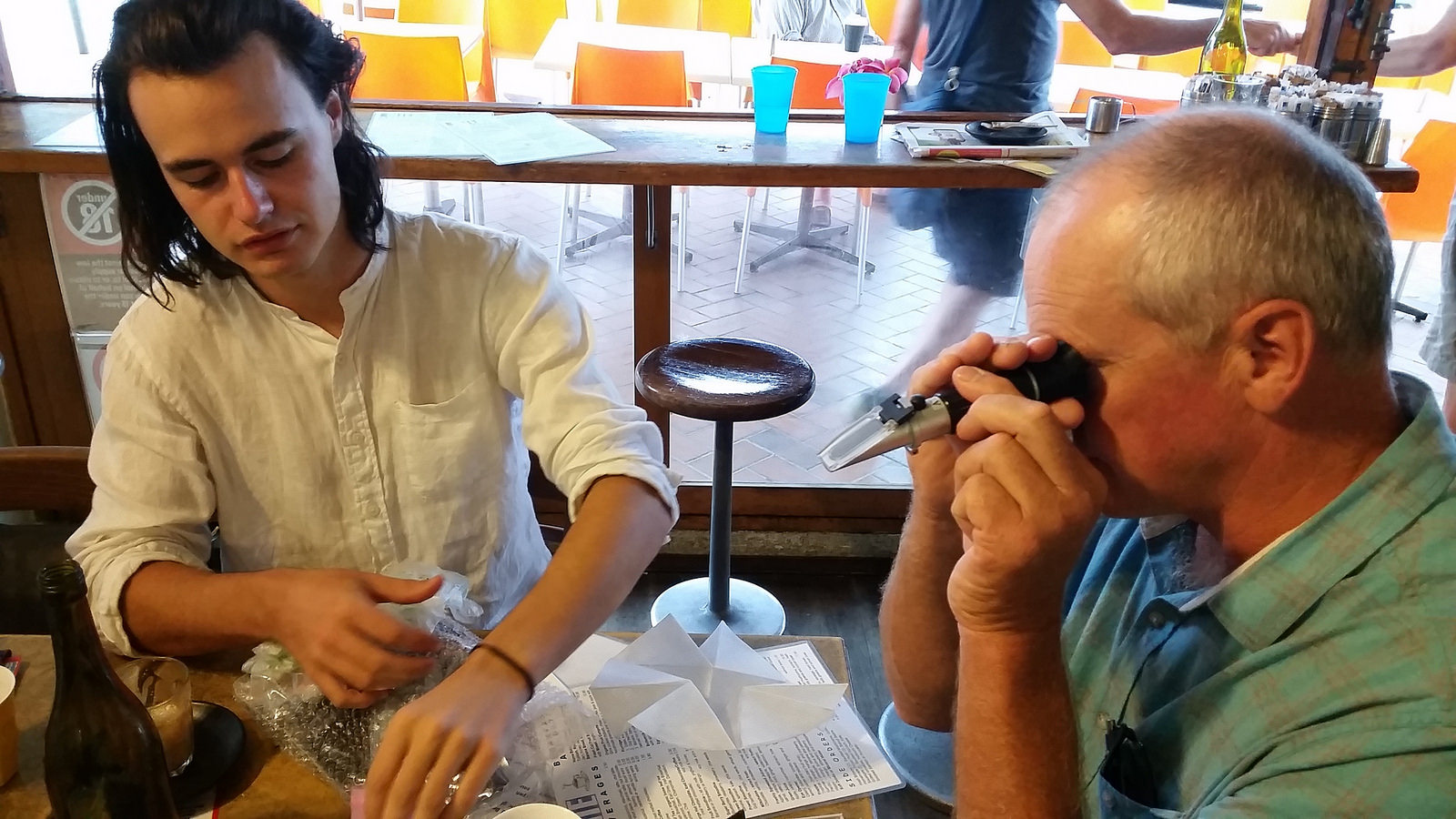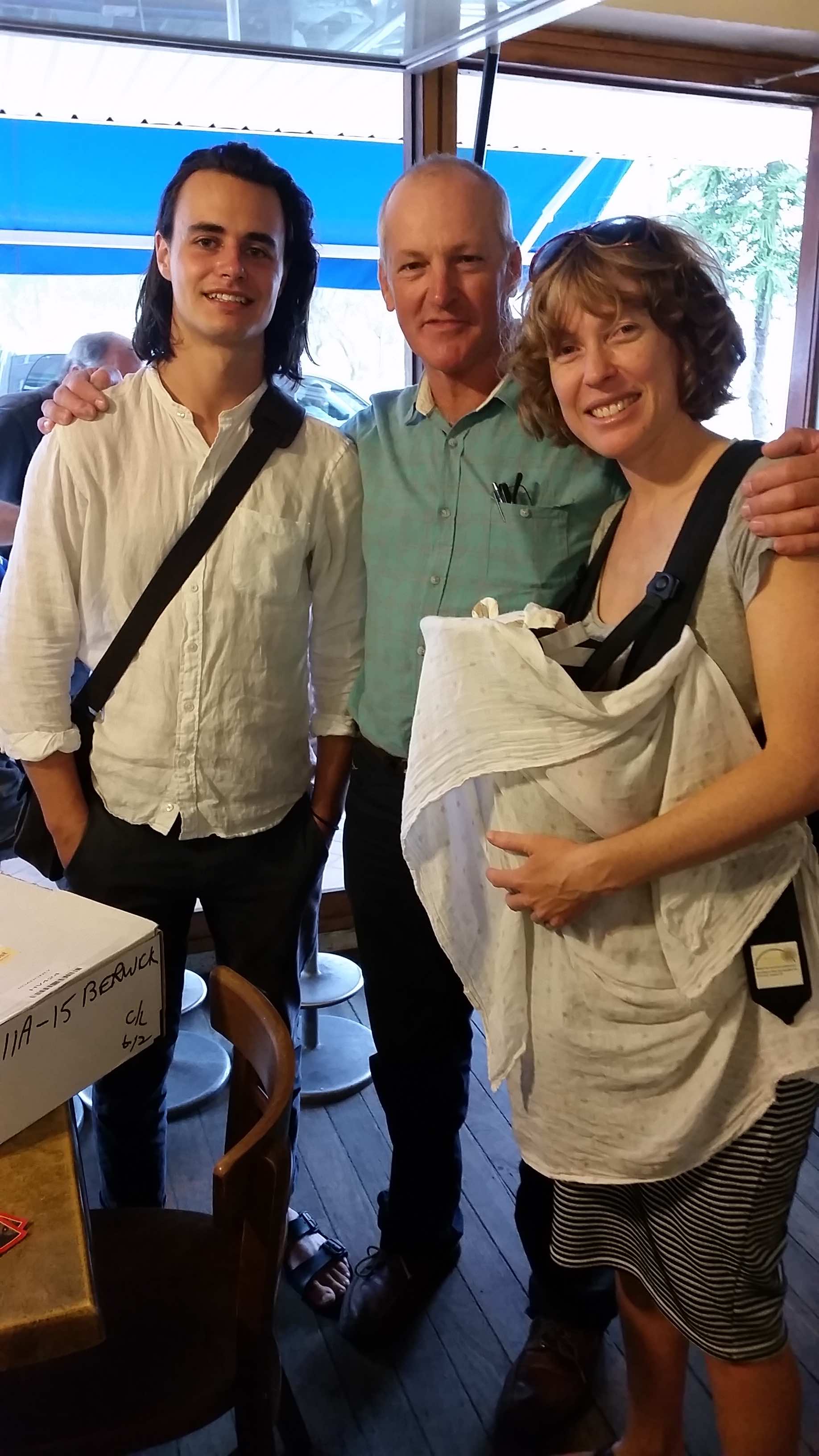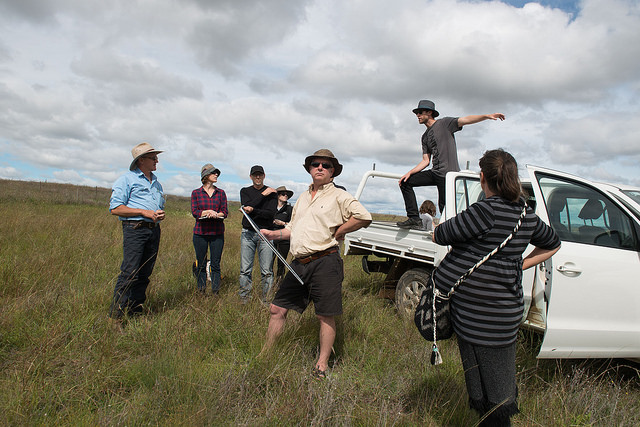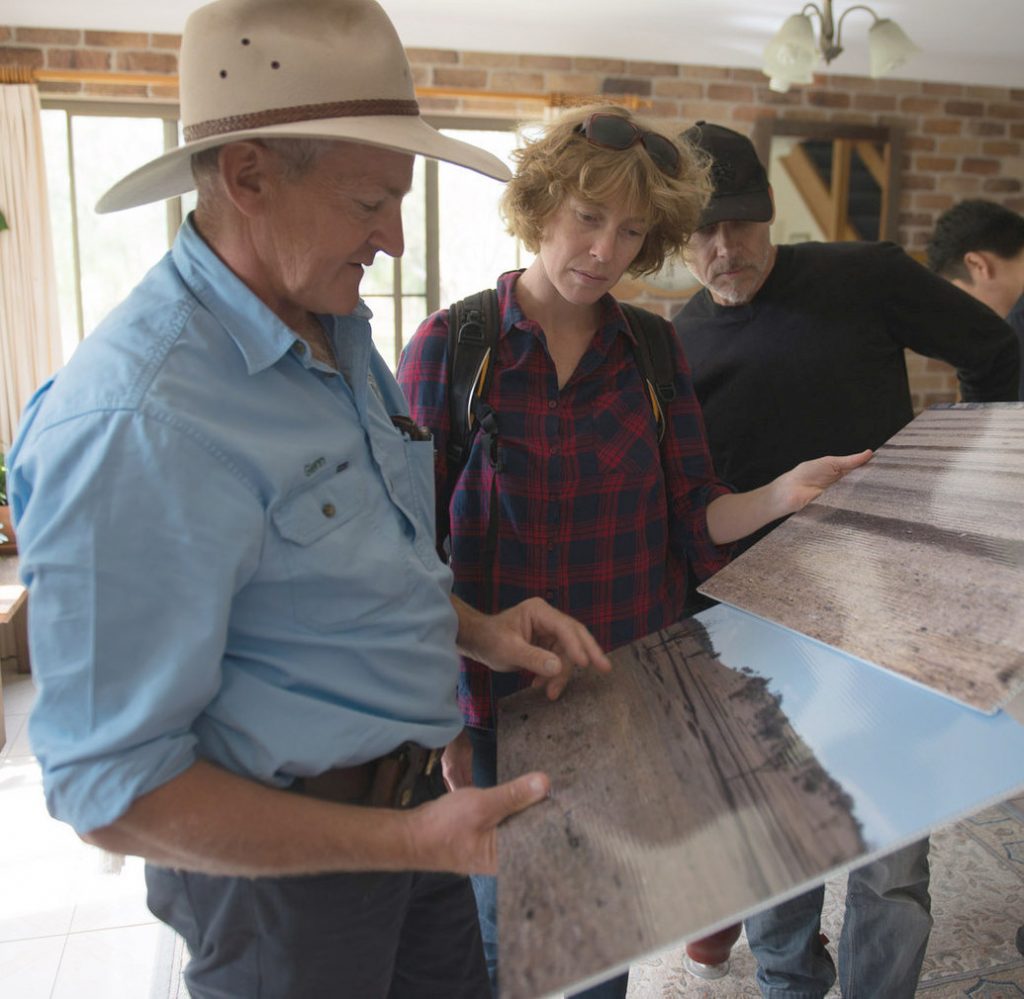Laura Fisher recalls the terrific launch event for ‘An artist, a farmer and a scientist walk into a bar…’
Forage Farms
Carbon Science: Carbon Culture workshop
Amazing what you learn when you try new things.
Feast of Weeds recipe book
Click HERE to download a recipe booklet from the 'Feast of Weeds' project dinner at The Roxy. Featuring:
Salt Bush Chips
Stinging Nettle Focaccia
Cumbungi & Sow Thistle Slaw
Sow Thistle & Mallow Salsa Verde
and...
Roast Pumpkin & sauté Dandelion salad with honey and balsamic dressing
YUM!
Playing with Fire
An immersive model for humus:human?
By Laura Fisher
The more Glenn and I talked about humus, the more I felt like we needed another artist in the mix to tackle this behemoth topic with us. Enter Jono Bolitho!
Glenn speaks a lot about four interdependent cycles that are going on in humus: the water cycle, the nutrient cycle, the carbon cycle, and the nitrogen cycle. These cycles are engines of change: they transfer things, exchange things, synthesise things. They distribute the resources and energy that make plants grow, cool the ground, and make it rain.
Thinking about these cycles invites a kind of engineering imagination. Might we create a whole range of mechanical scenarios: 3-dimensional windows into the world in the soil that can be pumped, cranked, blown into? Little dioramas that get activated like music boxes or cuckoo clocks?
Then we began thinking spatially and architecturally. What if the interactive elements could be more encompassing? What if we could embed the person within the processes we want to illuminate?
This is when the concept of an immersive model really hit us. It's appealing as an idea because a model can be both illustrative and interactive, and because it feels like an exciting way to work at the intersection of art and science. Glenn also likes the educational dimension, as that’s one of the primary reasons he's working with us.
A Jono sketch
Models are usually about representing something in miniature: the Titanic, the solar system. For us, it’s the opposite. We’ll be scaling up and trying to give physical form to processes that are invisible to the naked eye. This is why thinking about the final outcome as an installation or a pavilion – a human-scaled environment - is so exciting, daunting as it is.
It makes me think of fungi wizard Paul Stamets’ description of a soil organism’s view of its environment: ‘you would be enmeshed in a carnival of activity, with mycelium constantly moving through subterranean landscapes like cellular waves, through dancing bacteria and swimming protozoa with nematodes racing like whales through a microscopic sea of life’.
What is humus?
by Laura Fisher
This is the first blog post for the collaborative project humus:human, which involves myself, artist Jono Bolitho, and farmer Glenn Morris.
How did this project come about? In 2017, members of KSCA visited Billabong, the organic grazing property Glenn manages in Inverell. We knew Glenn because he had attended Futurelands2, and also because he was a bit famous for riding his horse Hombre across the Sydney Harbour Bridge in protest against NSW land clearing laws (see here and here).
At Billabong we were hosted to a beautiful lunch with his wife Katrina, which featured Glenn’s own organic produce, and toured around to meet his very happy cows and pigs, and learnt about the work he’d done to regenerate the property. It was an amazing experience for all of us, and helped us understand what ‘regenerative agriculture’ really looks like in practice.
Glenn talked passionately about humus, and about how it was key to the regenerative work he’d done. Eloise wrote a little blog post about this here.
I knew nothing about humus, and started to look into it - Glenn gave me some advice on what to read. He had done extensive research during his Masters in Sustainable Agriculture, and told me the best writing on humus came from soil science that predates the mass take-up of industrial farming methods that rely upon synthetic fertilisers and pesticides (which is most agriculture today).
So I read bits and pieces of writing by people like Selman Waksman, the pioneering microbiologist and biochemist. In his 1936 book Humus: Origin, Chemical Composition and Importance in Nature, he writes that humus ‘probably represents the most important source of human wealth on the planet. Nature has stored… a vast amount of readily available energy, a large part of the carbon needed for life processes, and most of the combined nitrogen, so much needed for plant growth’.
The crux of it seems to be that in healthy soils, humus is both produced by, and a kind of infrastructure for, a whole universe of microorganisms that are circulating minerals and nutrients among themselves, as well as oxygen and water molecules, as well as various bio-chemical reactions and so on. The starting point for understanding humus is photosynthesis, the process by which plants convert carbon in the atmosphere - the sun's energy - into food. They use this food to build their bodies both above and below ground, but they ALSO pump a lot of it into the soil via their roots, where it is traded with microorganisms for other nutrients that the plant needs. So the carbon becomes a kind of chemical energy that fuels the fertility of soil.
Which is not to say that I now feel I understand humus. The wikipedia entry on it is oddly reassuring on this front:
“It is difficult to define humus precisely because it is a very complex substance which is not fully understood. Humus is different from decomposing soil organic matter. The latter looks rough and has visible remains of the original plant or animal matter. Fully humified humus, on the contrary, has a uniformly dark, spongy, and jelly-like appearance, and is amorphous; it may gradually decompose over several years or persist for millennia. It has no determinate shape, structure, or quality. However, when examined under a microscope, humus may reveal tiny plant, animal, or microbial remains that have been mechanically, but not chemically, degraded. This suggests an ambiguous boundary between humus and soil organic matter. While distinct, humus is an integral part of soil organic matter.”
There's something very appealing about diving into a topic that an expert community agrees "is not fully understood". Time to bring in the artists I say! Glenn, unlike the rest of us, seems not to be confused about humus. Last year I asked him to define it for me, and I'm so glad I recorded our conversation. He held an imaginary handful of it, feeling its texture and said this:
“So we’ve got the organic matter breaking down, the lignin material, we’ve got the organic compounds, the sugars coming through the root system, we’ve got all sorts of other soil life breaking down, dying, reproducing, the microbes, the fungus, the sugars, so the whole lot is interacting, and then, they’re bonding with the cations in the soil, so you get a bridging effect between the humus and the clay particles in the soil, so all of this is forming what we call stable humus. It’s a very complex situation.”
Yes. It sounds like a very complex situation indeed.
The transformation of Billabong
Reflections on cultural adaptation in practice
By Alex Wisser
Kandos School of Cultural Adaptation was recently invited to speak at “What do we teach, how do we learn”, a Sydney Biennale event at Artspace querying the relationship between art and teaching. It fell to me to string together some semi-cogent sentences in representation of our group. Preparing for the talk proved itself an exercise in arbitrary narrative synthesis because our group is very intentionally structured to maintain the multiplicity of its members and does not easily reduce to a unified common voice or position. So, attempting to “speak for the group” is itself problematic.
My solution was to begin with a disclaimer not unlike the one above and then to concentrate on exactly the “soft structure” of our group as a subject matter, throwing in some reflection on my own ‘pedagogical’ experience as a member of the Kandos School of Adaptation’s student body (seeing as this was the subject of the talk – and also a favorite subject for reflection of mine). The text below is adapted from the original talk.
The Kandos School of Cultural Adaptation began life as a fiction that grew up to become a real thing (not unlike an artwork). Despite its newfound reality, the structure of KSCA retains the unreal quality of its fictional beginnings and having none of the material trappings we would normally associate with an institution of learning, the school itself became its name – a moniker that when placed onto a project would magically render the institutional resources of KSCA at the disposal of that project. Through this fluid structure, the individual members of the group are able to maintain our own initiative while still having recourse to the collective support and engagement of the group.
It occurs to me that this structure might be called superficial. It organizes from the surface as more of an exoskeleton than an endoskeleton. It possesses little essential identity but becomes what it becomes through the activity we pursue in its name. The signifier remains constant as the signified shifts beneath it.
This does not mean that it has no structure. The four words Kandos School of Cultural Adaptation regulate and organize whatever content they are given. Whatever activity is placed beneath them becomes subject to the aperture that the name imposes. Any activity so designated becomes a learning activity and the subject of that learning, its discipline if you will, is the phenomena of cultural adaptation. Instead of imposing these elements upon a project as their a priori criteria for inclusion, these elements are discovered, emphasized and brought into focus within the activity of any project adopted by the group.
The term ‘cultural adaptation’ refers to the idea that if art can be seen as an activity that functions specifically to adapt culture to the changing conditions of social reality, then any activity that changes culture can be seen as art. Art, defined as cultural adaptation, leaves the museum and gallery cul de sac and opens onto the entire field of cultural activity. It can take place anywhere. It happens in the office or the block of flats, at the bus stop or the parking garage, it happens in a paddock or at a football game. It happens at any point within our society at which conventional practice is challenged, shifted or broken in the pursuit of new cultural modes often catalysed by a changing social reality. For an artist, the prospect of applying the conceptual and communicative strategies of my art practice to a point of cultural change outside of the artworld is very exciting.
Glenn Morris shows us historic images of Billabong, the property now under his regenerative management
To put this into relief, our current project “An Artist, A Farmer and a Scientist walk into a bar…” centres around a community of farmers who, on their own initiative, compelled by economic necessity as much as ethical or idealistic concern, are turning away from the high input conventions of chemical dependent industrial farming toward methods that regenerate soil fertility, cultivate biomass and encourage soil water retention. In pursuing these changes in their practices, they place themselves in contrast to the forces and interests of the existing industrial farming economy as well as the conventional farming community to which they had previously belonged. As a result, they face a resistance that seems to encompass the existing social world.
Tim Wright's impressively healthy grasslands produced through holistic management practices on Lana NSW
What I believe we are witnessing and potentially participating in, is a point of cultural change. Material social and economic pressures are building within a certain regime of practice and this is driving a change in behavior amongst those who directly participate within it. This change meets its necessary resistance in the form of the status quo: the culture as it exists closes ranks against the perceived threat of change, presenting a united front that stretches from the company board room to the local pub, from the evening news to the queue at the newsagents.
So, you might ask, how does an artist 'participate' at this point of cultural change? That is something we are still learning. And that perhaps is the most appropriate answer. It occurs to me that all of art is but a specific form of learning - an observation of the world made through an attempt to reflect, present or represent it. It is for this reason that artists loose interest in a work as soon as they know what they are doing - there is no learning to be gained from it.
To use my own circumstances as an example, agricultural practice is not only a subject of which I am profoundly ignorant, but also a subject in which I had no previous interest. I am not drawn to it as a preoccupation but through this project, I find myself (along with all of my preoccupations) nonetheless immersed within it. I am engaging with an entire realm of experience that I would have never chosen for myself, because I had no intellectual connection to it. For me, this circumstance or the circumstantial nature of KSCA predicates a kind of learning that is difficult or even impossible in more traditional educational contexts. Instead of working within the field or discipline of my competence, I (along with all my competencies) am dropped into a world of which I am manifestly ignorant. And what better place from which to acquire an education than ignorance.
The learning that occurs at this point of contact between my “self” and the world for which I am not prepared is incredibly generative. The world I bring with me, in its efforts to comprehend the world I am entering, begins to generate connections that were inconceivable before the confrontation I am attempting to describe. In the process, the resistance of the world I thus struggle to understand, challenges and decomposes much of the understanding I throw at it, forcing it (my understanding) to regenerate in forms that have been altered by the process. If left to my own devices, I would only have my own devices to work with, and little enters from the outside.
Rick Hutton shows the KSCA crew around The Living Classroom at Bingara
Which brings me back to cultural adaptation because it is an idea that I now carry with me everywhere. It functions less a matrix through which I can render the world comprehensible, and more as a question that I can ask at those points that I don’t understand what is going on. The question, if I were to formulate it out loud, would sound something like “How does this thing participate in cultural change?” This question is not something that I have to answer, nor really should I. The answer will come with the change that the question interrogates – it might take 10 years for the answer to emerge. In the meantime, I have a fulcrum for lifting that change into a perspective from which I can observe it, learn from it, and hopefully participate in the adaptation we make as a society to that change.
In the context of the AFS project, this method has already produced some striking results. Through conversation with our partners, we were able to identify a point at which we as artists might begin to contribute to their work. These farmers, whom I believe to be at the leverage point of a broader cultural change, find themselves isolated on three levels: from the conventional farmer community who view their activity with suspicion, from other farmers pursuing similar methods (for no other reason than that they are isolated geographically) and from the scientific community that will ultimately sanction or deny the value of the work they are doing. This isolation is particularly frustrating as it also excludes them from participating in the broader national conversations around environmental and land care concerns.
From this recognition we have devised a number of strategies that target these constraints, creating connection and allowing blocked energy to flow. “An Artist, a Farmer and a Scientist walk into a bar…” develops these strategies through eight engagement projects that will stir dialogue, establish lines of communication, and hopefully resonate the results to targeted audiences.
Its all about the grass
Beyond the specific, concrete applications, the KSCA method has another, unexpected outcome. By looking at our subject as a point of cultural change, I no longer perceive the vast, static and immovable mass of the existent world in its Goliath opposition to the infinitesimal David-like band of farmers advocating for change. What I look at now is a site of culture change: far from being an isolated movement in a static landscape of enduring truths and realities, it is a particular point of change within a culture that exists in a constant state of movement. What it will change into is a matter of how we adapt to it. If left to its current tendencies, the culture will likely degenerate into a more and more destructive modes of behavior. But likewise, it opens the possibility that we can adapt this cultural change to better fit our changing material and social circumstance. No longer is the struggle conceived as that of moving a mountain – the mountain is already in motion; the challenge is how we direct its movement.
Sowing Stories
By Leanne Thompson
On Saturday, March 3, Big Fag Press hosted Sowing Stories, a workshop in social media strategies for ethically engaged creatives by Kirsten Bradley of Milkwood Permaculture fame. The event sold out straight away and on the day an interesting bunch of people walked through the door. Along with KSCA members Alex, Laura, Lucas and Kim, were a couple of dozen participants, some from groups or businesses including NAVA, Frontyard, Lush and Feather and Bone. The common thread was a desire to build the social potential in communities and share actions that hinged on care, generosity and enthusiasm. Kirsten describes this energy as a wonderful sharing of ethical lives to invigorate connections.
Kirsten’s discussion was far ranging in all things that constituted online communication; from platforms, mission statements, time management, livelihoods and advocacy to technical details, big data, and conflict negotiation. There was a robust conversation about the knowledge present in the room regarding social media and Kirsten offered an enlightening glimpse into Milkwood’s remarkable achievement transforming from a farm into a ‘state of mind’ that is able to tap into an invisible but like-minded community.
Kirsten honed the morning’s dialogue down to some great insights and skills we could take away.
Words to savour are the linchpin for crafting a compelling blog which she holds central to any online communication. A website blog can act as a long term archive and also the hub from which you can schedule frequent updates and feeds to other platforms such as Facebook, twitter and u-tube creating an efficient use of time and energy. Creating clear, effective and delicious content is also the cornerstone of newsletters that offer a direct link to your community’s email inbox.
Beautiful visuals encourage your audience through the gate. Using the skills of a designer to create a great looking website and autonomous information/advertising panels will be enticing and really help easy navigation around your content and archive. A well framed image can boost text and is the key to great Instagram posts and Kirsten advised it was worthwhile to build up your photographic skills and always take lots of images while things are happening, it’s great for quick instant feeds and as a reminder and resource to draw on later.
Honest voices are inviting and real. Kirsten acknowledged that there are a few tensions present in negotiating the online terrain. Telling the story as a project unfolds will often straddle boundaries; between personal and professional, community and commercial and agreement and discord and she had some great insights about each.
Determining the voice to use before you begin will clarify parameters around personal narrative and objectivity from a project perspective. Is that thing you consider a fascinating intricacy to be explored in detail really that interesting to others or have you disappeared down the rabbit burrow?
Sharing the highs and lows along a project’s journey recognises that knowledge isn’t settled and processes can be open to experimentation and discussion. Kirsten spoke of authentic storytelling with little pretence, creating a flow in the journey that is engaging and avoids getting caught up in those eureka moments of success which lead to an definitive ‘this is how you do it’ attitude. This approach allows the story to zoom in and out between specific detail and general ideas.
A great strategy to get people talking can be to ask a really good question. If the question is well formed it can build a discussion that informs both your project and audience and means that you’re solving problems together. A good tip was to trial ideas and content on some trusted friends to test the water on potential responses before posting it online!
Milkwood’s activities also need to support Kirsten’s family and the crew involved. Her approach to an ethical and sustaining livelihood is to be upfront about their marketing and advertising. She promotes those activities as the deeper and hands-on engagements that lead on from the freely offered education, insight and advocacy.
Kirsten’s easy and approachable character infuses Milkwood’s online presence. It is understandable that she also transfers this approach to negotiating conflict when it pops up in a comment or conversation. She calls this a ‘non-defending’ style and said her aim was to model best practice as it was incredibly influential to the wider network. Her hint is to stay on your own page (don’t take the battle to other people’s pages where you don’t have control), be cool and look for something positive in the comment as an entry point to respond. Pushback can be positive, it shows that a raw nerve has been exposed and that tension can be useful to question if a concept is understood or to widen the discussion to consider different perspectives. Rather than unravelling, common threads and values are woven together through Kirsten’s considered negotiations and this in turn consolidates the Milkwood community.
The workshop was packed with information and strategies relevant to the community initiatives and ethical businesses present, fostering skills and a connective network for their projects. Big Fag Press was a great venue and Marnie’s morning tea both beautiful and delicious. Kirsten clearly pointed to the social potential of storytelling. Create a package that unfolds: if you can tempt others to look here with an intriguing tale, a chunk of research can be uncovered in the documentation of an activity, great photos make it visible, people are drawn into conversation and by having a go themselves, a bigger picture of alternatives comes into view, and then you have seeded a real community and growing resource.




































